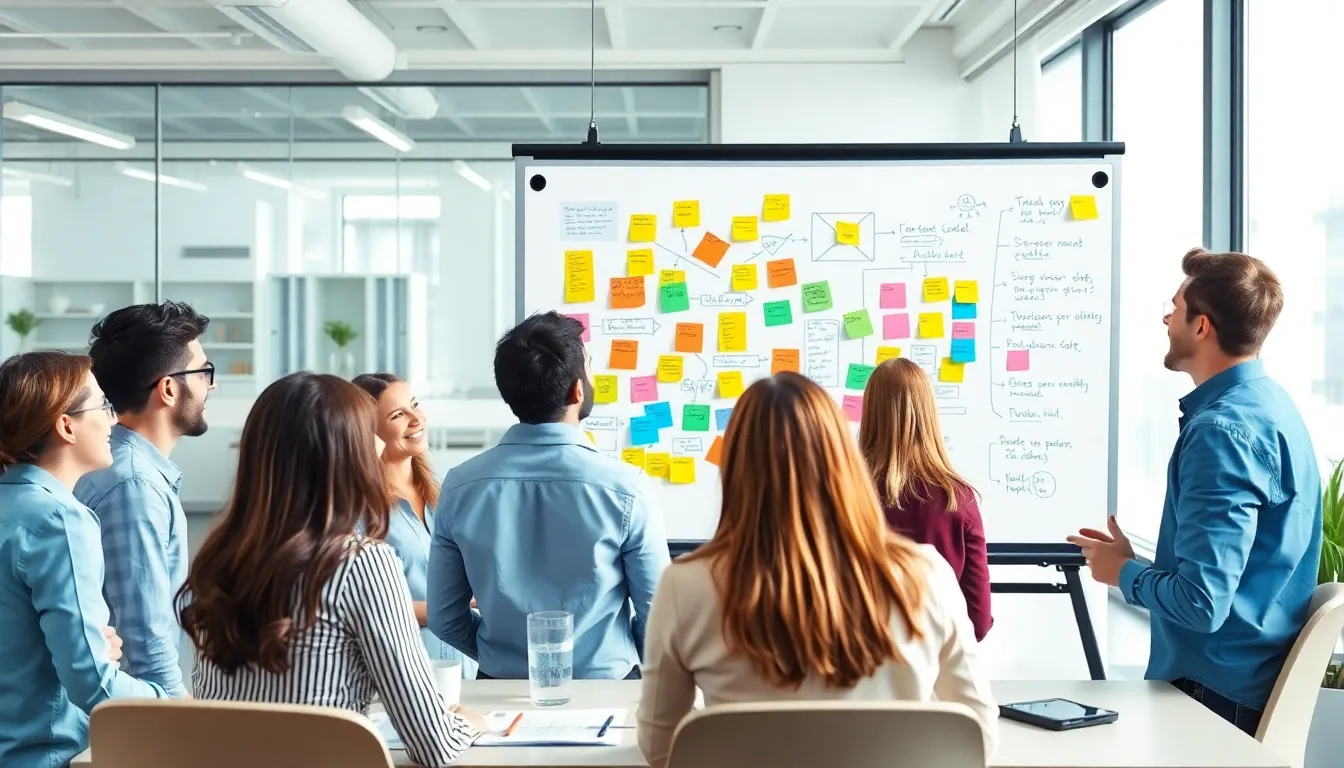In a world where innovation reigns supreme, creative thinking isn’t just a nice-to-have; it’s a must-have. Whether you’re brainstorming the next big idea or simply trying to spice up your daily routine, tapping into that creative reservoir can feel like searching for a needle in a haystack. But fear not! With the right exercises, anyone can unleash their inner Picasso—or at least their inner doodler.
Table of Contents
ToggleUnderstanding Creative Thinking
Creative thinking involves generating new ideas and approaches by viewing situations from different perspectives. Engaging in creative thinking is beneficial across various aspects of life.
Definition of Creative Thinking
Creative thinking refers to the ability to think outside traditional boundaries. Often, it encompasses the generation of unique concepts and solutions. This cognitive process utilizes imagination, intuition, and reasoning to solve problems or produce innovative outcomes. Different techniques can enhance creative thinking, such as brainstorming and mind mapping. Expressing creativity can manifest in various forms, including artistic projects and everyday decision-making.
Importance of Creative Thinking
Creative thinking plays a crucial role in problem-solving and innovation. Organizations thrive when employees embrace creative approaches, leading to improved efficiency. Individuals who engage in creative thinking often find themselves better equipped to face challenges. This skill fosters adaptability and resilience in an ever-changing environment. Engaging in creative exercises can lead to breakthroughs and significant advances, whether in business or personal life. Ultimately, cultivating creative thinking enhances one’s ability to navigate complexities effectively.
Types of Creative Thinking Exercises

Various creative thinking exercises facilitate idea generation and problem-solving. Engaging in these activities sharpens mental capabilities and stimulates innovative thought.
Brainstorming Techniques
Brainstorming techniques optimize group creativity and individual insight. Structured sessions promote idea flow; participants share thoughts without criticism. Use strategies like round-robin brainstorming, where each person contributes in turn. Encourage wild ideas to inspire unconventional thinking. Implementing timed sessions helps maintain focus, pushing individuals to think quickly. Moreover, mind dump exercises allow participants to jot down ideas freely, creating a visual pool to explore. Organizing sessions with clear goals drives effective discussions and outcomes.
Mind Mapping Strategies
Mind mapping strategies visually organize thoughts. Central concepts form the map’s core, branching into related ideas. Begin with a main idea, then expand outward, linking associated thoughts. This exercise aids in seeing connections among concepts, enhancing understanding. Using colors and images makes the map engaging and memorable. Mind maps serve as dynamic tools for brainstorming, planning, and study. Regularly revisiting and updating mind maps fosters continued creativity, making them indispensable in various creative projects.
Practical Creative Thinking Exercises
Engaging in creative thinking exercises enhances problem-solving and idea generation. Practical activities can be easily integrated into daily life.
Everyday Scenarios
In everyday situations, creativity can flourish through simple actions. Taking a different route to work often sparks new ideas. Practicing “what if” scenarios encourages exploration of alternatives, prompting innovative solutions. Keeping a journal captures spontaneous thoughts and reflections, which leads to enhanced creativity. Doodling during meetings allows the mind to wander, often resulting in unexpected insights. Utilizing everyday objects for inspiration fosters imaginative thinking, unveiling fresh perspectives.
Group Activities
Group activities enhance collaborative creativity. Organizing brainstorming sessions generates numerous ideas quickly. Assigning roles during these sessions encourages participation from everyone, strengthening teamwork. Exploring visual prompts stimulates engagement, often leading to dynamic discussions. Conducting a round-robin exercise ensures each participant contributes, fostering a sense of belonging. Playing improvisational games promotes quick thinking and adaptability among group members, enhancing collective problem-solving skills.
Benefits of Creative Thinking Exercises
Creative thinking exercises offer numerous advantages for individuals seeking to enhance their cognitive abilities. Engaging in these activities fosters a dynamic approach to problem-solving and boosts overall efficiency.
Enhancing Problem-Solving Skills
Creative thinking exercises sharpen problem-solving skills by encouraging unconventional approaches. Individuals often discover alternative solutions when brainstorming outside the traditional frameworks. These exercises also cultivate flexibility, enabling individuals to adapt strategies when faced with obstacles. By practicing diverse techniques, like mind mapping, participants also clarify complex issues, facilitating clear pathways to solutions. The repetitive nature of these activities strengthens mental agility, making it easier to navigate challenges.
Boosting Innovation and Productivity
Collaborative creative exercises significantly increase innovation and productivity within teams. By fostering a culture of open-mindedness, team members propose fresh ideas without fear of judgment. Imaginative brainstorming sessions result in unique concepts that drive projects forward. Engaging in structured activities also streamlines workflows, enhancing focus and task execution. With consistent practice, individuals enhance their intrinsic motivation, leading to a more innovative mindset. Such exercises contribute to a more creative environment, ultimately yielding higher productivity across various endeavors.
Embracing creative thinking exercises can transform the way individuals approach challenges and opportunities. By incorporating these practices into daily routines, they can unlock new levels of innovation and adaptability. Whether through individual activities or collaborative sessions, the potential for growth and discovery is immense.
As creativity flourishes, so do problem-solving skills and the ability to navigate complexities. Engaging regularly in these exercises not only enhances cognitive flexibility but also fosters a vibrant environment where unique ideas can thrive. The journey toward unleashing creativity is ongoing, and every step taken brings individuals closer to realizing their full creative potential.


